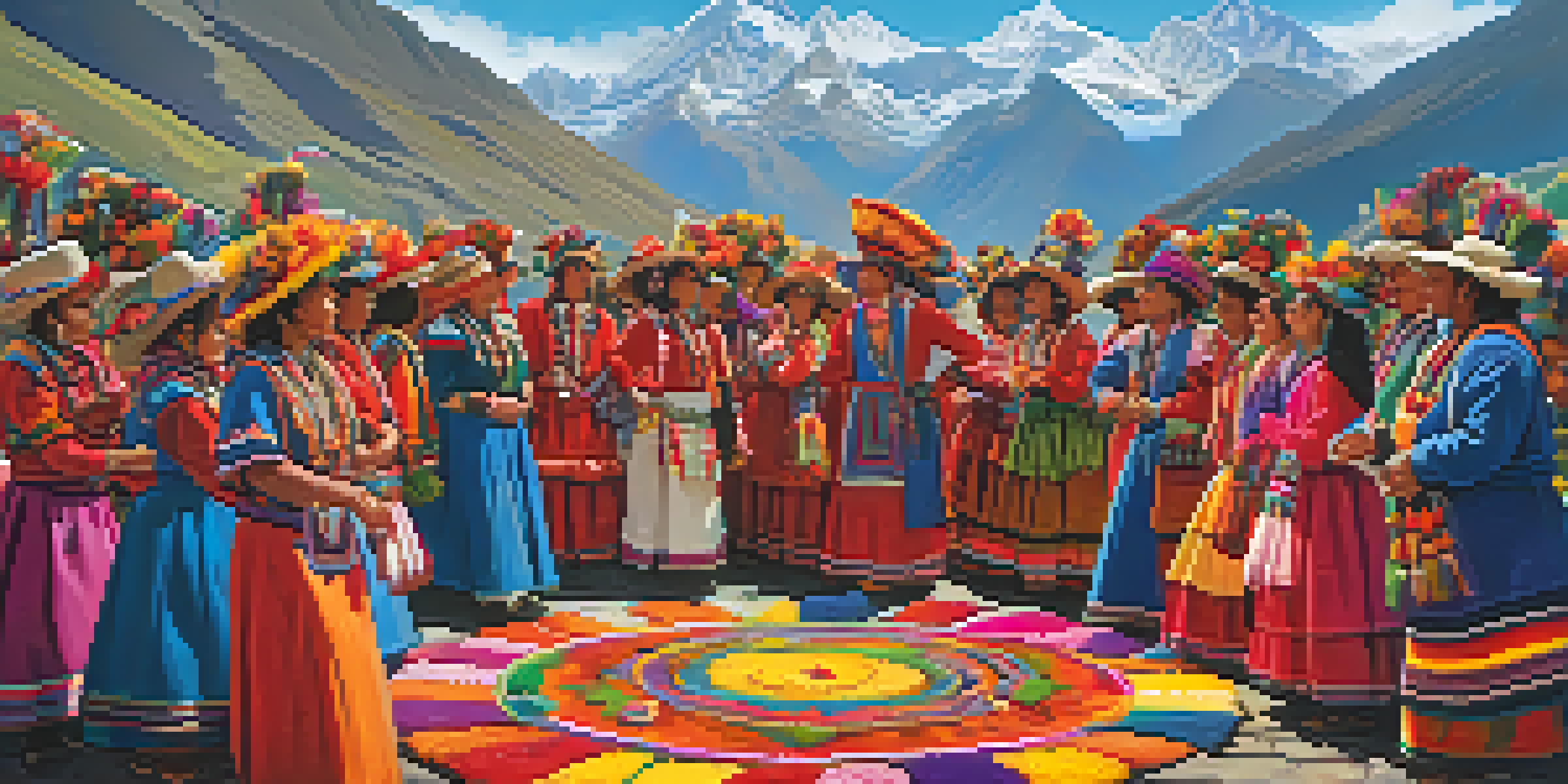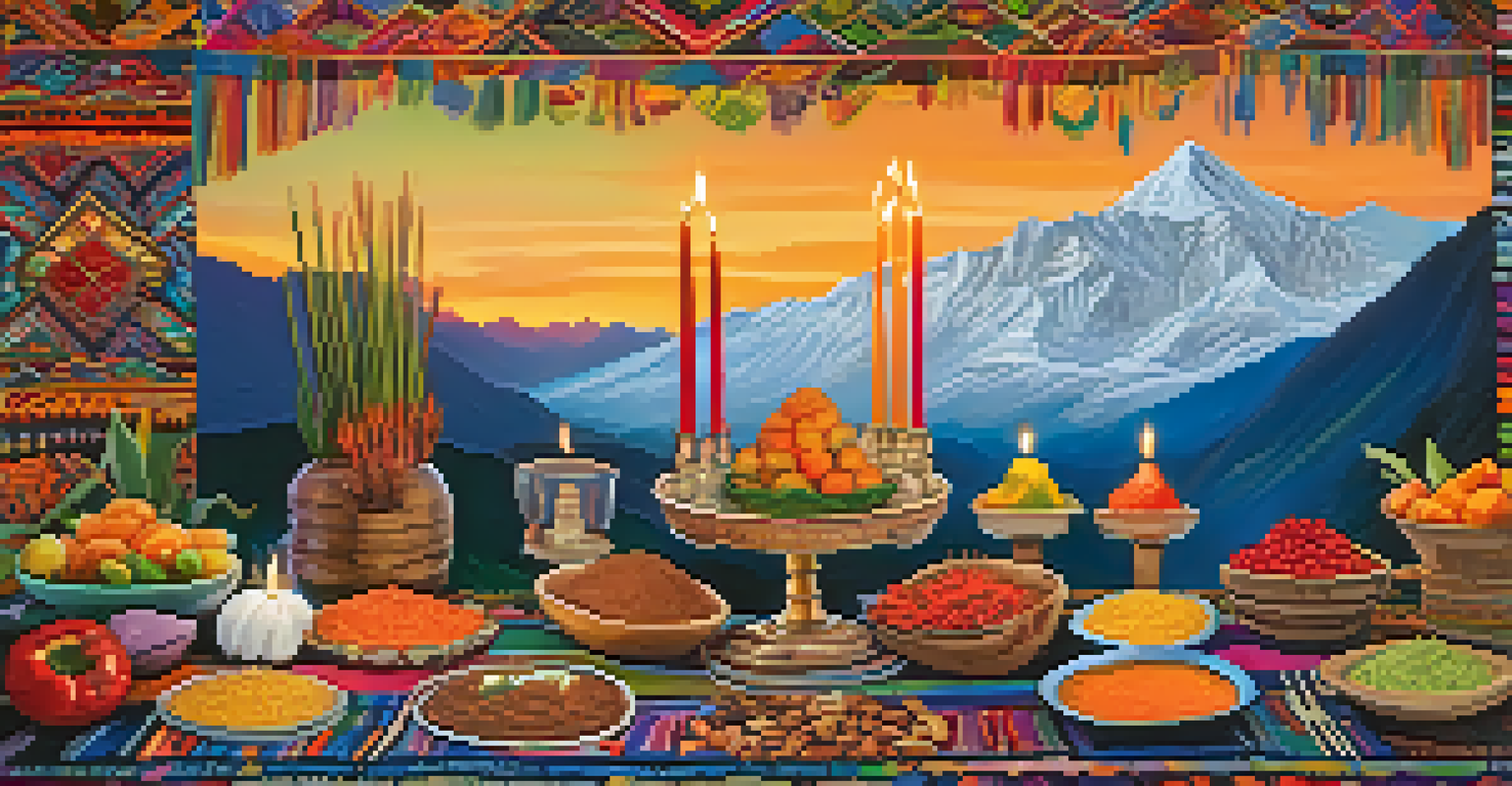Andean Spirituality: Beliefs and Practices Across Regions

Understanding the Roots of Andean Spirituality
Andean spirituality is deeply intertwined with the cultures of the Andean mountain range, which stretches across countries like Peru, Bolivia, and Ecuador. This spirituality is not merely a set of beliefs; it reflects a way of life that honors the natural world and the interconnectedness of all beings. It is rooted in ancient traditions that have been passed down through generations, often blending indigenous beliefs with elements of Catholicism introduced during colonization.
The land is not just a resource; it is a living entity, deserving of respect and care.
At its core, Andean spirituality emphasizes the importance of Pachamama, or Mother Earth, who is revered as a nurturing figure that sustains life. The Andean people view themselves as caretakers of the land, fostering a reciprocal relationship with nature. This relationship is not just spiritual but also practical, as agricultural practices are often guided by ancestral knowledge and celestial events.
Through rituals, offerings, and ceremonies, Andean spirituality acknowledges the spiritual dimension of the environment. These practices often include vibrant festivals and communal gatherings that celebrate the cycles of nature, demonstrating a profound respect for their surroundings and a desire to maintain harmony with the universe.
Key Beliefs in Andean Spirituality
Central to Andean spirituality are concepts like reciprocity, balance, and the duality of life. The principle of 'ayni,' or reciprocity, plays a crucial role, suggesting that what one gives to the earth and to others will return in kind. This belief fosters a sense of community and encourages sustainable living, as individuals are reminded of their obligations to both people and nature.

Another significant aspect is the connection to the 'Apus,' or mountain spirits, which are believed to be guardians of the land and its people. Each mountain is viewed as a living entity with its own spirit, deserving of respect and offerings. This connection reinforces the idea that the Andean people are part of a broader spiritual landscape, where every element has its role and significance.
Pachamama: The Heart of Andean Beliefs
Andean spirituality centers around Pachamama, or Mother Earth, emphasizing a nurturing relationship between people and nature.
Additionally, the concept of 'Suma Qamaña' translates to 'living well' and reflects a holistic approach to life that values harmony within oneself, with society, and with nature. This philosophy encourages individuals to seek balance in their lives, cultivating well-being and communal prosperity.
Rituals and Offerings in Andean Practices
Rituals are a fundamental aspect of Andean spirituality, serving as a means to connect with the divine and express gratitude. One of the most common practices is the 'despacho,' a ceremonial offering that involves creating a colorful arrangement of food, flowers, and other sacred items. This offering is often made to Pachamama or the Apus, symbolizing thanks and a request for blessings.
To live well is to live in harmony with oneself, with society, and with nature.
These rituals are not performed in isolation; they are often communal events that strengthen community bonds. Families and neighbors come together to participate, sharing in the process and reinforcing collective values. The act of giving and receiving during these rituals fosters a sense of unity and shared purpose among participants.
In addition to the despachos, other significant rituals include 'Inti Raymi,' the Festival of the Sun, and 'Kuarikuy,' a celebration of the harvest. These events are marked by traditional music, dance, and colorful clothing, creating a vibrant tapestry of cultural expression that honors both the spiritual and the physical aspects of life.
The Role of Nature in Andean Spirituality
Nature holds a sacred place in Andean spirituality, serving as both a source of sustenance and a spiritual guide. The Andean landscape, with its towering mountains, flowing rivers, and fertile valleys, is viewed as a living entity filled with spirits. Each element of nature is believed to possess its own energy and wisdom, offering lessons and guidance to those who are attentive.
The changing seasons and natural cycles are also integral to Andean spirituality. For example, the agricultural calendar is closely aligned with celestial events, such as the solstices and equinoxes. Farmers rely on these cosmic rhythms to determine the best times for planting and harvesting, reflecting a deep understanding of the interconnectedness of life.
Rituals Foster Community Connections
Rituals such as despachos and festivals play a crucial role in strengthening community bonds and expressing gratitude.
Moreover, many Andean spiritual practices involve rituals that honor the seasons, such as planting ceremonies that invite the blessings of the earth. By recognizing the spiritual significance of nature, the Andean people cultivate a profound respect for their environment, reinforcing the idea that the health of the land is directly linked to their own well-being.
Regional Variations in Andean Spirituality
While Andean spirituality shares common threads across the region, distinct regional variations reflect the diverse cultures and histories of the people. In the highlands of Peru, for example, the worship of Pachamama is particularly pronounced, with elaborate ceremonies held during agricultural festivals. These events often involve music, dance, and communal feasting, emphasizing the importance of community in spiritual practices.
In contrast, the Aymara people of Bolivia have their own unique interpretations of Andean spirituality, which include a rich tradition of ancestor veneration. They believe that the spirits of their ancestors play an active role in their lives, offering guidance and protection. This connection to ancestry is reinforced through rituals that honor the deceased, demonstrating the continuity of life beyond death.
Ecuadorian Andean spirituality often incorporates elements from both indigenous and mestizo cultures, resulting in a rich tapestry of beliefs and practices. Here, the celebration of the 'Fiesta de la Mama Negra' exemplifies the blending of traditions, where participants pay homage to both indigenous and African heritage through vibrant processions, music, and dance.
Andean Spirituality and Modern Influences
In recent years, Andean spirituality has experienced a resurgence as communities seek to reconnect with their cultural roots. This revival is not just about preserving ancient traditions; it also involves adapting spiritual practices to contemporary life. Many young people are now engaging with their heritage, participating in rituals and ceremonies that were once considered outdated or irrelevant.
Additionally, the globalization of culture has led to a fascinating exchange of ideas, where Andean spirituality is increasingly recognized and respected beyond its geographical origins. Workshops, retreats, and spiritual tours focused on Andean practices have gained popularity among both locals and tourists, fostering a greater appreciation for these rich traditions.
Nature Guides Andean Spirituality
The Andean landscape is viewed as a living entity, with natural cycles informing spiritual practices and agricultural activities.
However, this modernization comes with its challenges, as the commercialization of spirituality can sometimes dilute its significance. It’s essential for communities to navigate this landscape carefully, ensuring that their practices remain authentic and meaningful while still being accessible to a broader audience.
The Future of Andean Spirituality
As the world continues to change, the future of Andean spirituality is likely to evolve while maintaining its core values. The emphasis on environmental stewardship inherent in Andean beliefs may resonate more strongly as global discussions around sustainability and climate change intensify. This alignment could inspire new generations to embrace their traditions as they seek solutions to contemporary challenges.
Furthermore, the blending of Andean spirituality with other worldviews may lead to innovative practices that honor both heritage and modernity. Collaborative efforts between indigenous communities and outsiders can foster mutual respect and understanding, creating a space for dialogue and shared learning.

Ultimately, the resilience of Andean spirituality lies in its adaptability and its deep-rooted connections to the land and community. As long as these values are upheld, Andean spirituality will continue to thrive, offering wisdom and guidance for those who seek a deeper connection to the world around them.